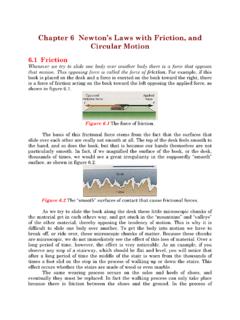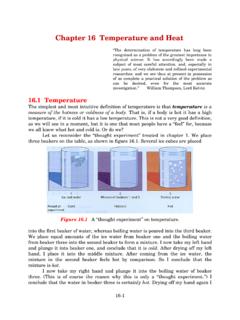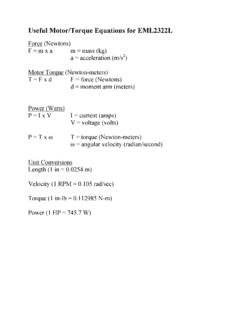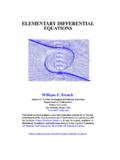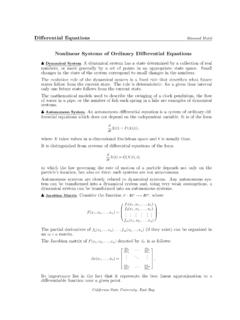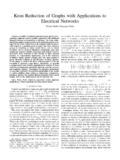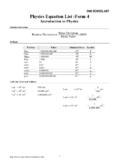Transcription of Chapter 13 Simple Harmonic Motion - farmingdale.edu
1 Chapter 13 Simple Harmonic Motion We are to admit no more causes of natural thingsthan such as are both true and sufficient to explaintheir appearances. Isaac Introduction to Periodic MotionPeriodic Motion is any Motion that repeats itself in equal intervals of time. Theuniformly rotating earth represents a periodic Motion that repeats itself every 24hours. The Motion of the earth around the sun is periodic, repeating itself every 12months. A vibrating spring and a pendulum also exhibit periodic Motion . The periodof the Motion is defined as the time for the Motion to repeat itself.
2 A special type ofperiodic Motion is Simple Harmonic Motion and we now proceed to investigate Simple Harmonic MotionAn example of Simple Harmonic Motion is the vibration of a mass m, attached to aspring of negligible mass, as the mass slides on a frictionless surface, as shown infigure We say that the mass, in the unstretched position, figure (a), is inits equilibrium position. If an applied force FA acts on the mass, the mass will bedisplaced to the right of its equilibrium position a distance x, figure (b).
3 Thedistance that the spring stretches, obtained from Hooke s law, isFA = kxThe displacement x is defined as the distance the body moves from its equilibriumposition. Because FA is a force that pulls the mass to the right, it is also the forcethat pulls the spring to the right. By Newton s third law there is an equal butopposite elastic force exerted by the spring on the mass pulling the mass toward theleft. Since this force tends to restore the mass to its original position, we call it therestoring force FR. Because the restoring force is opposite to the applied force, it isgiven byFR = FA = kx ( )When the applied force FA is removed, the elastic restoring force FR is then the onlyforce acting on the mass m, figure (c), and it tries to restore m to its equilibriumposition.
4 We can then find the acceleration of the mass from Newton s second law asma = FR = kxThus,a = k x ( ) m 13-1 Figure The vibrating is the defining equation for Simple Harmonic Motion . Simpleharmonic Motion is Motion in which the acceleration of a body is directlyproportional to its displacement from the equilibrium position but in the oppositedirection. A vibrating system that executes Simple Harmonic Motion is sometimescalled a Harmonic oscillator.
5 Because the acceleration is directly proportional to thedisplacement x in Simple Harmonic Motion , the acceleration of the system is notconstant but varies with x. At large displacements, the acceleration is large, at smalldisplacements the acceleration is small. Describing the vibratory Motion of the massm requires some new techniques and we will do so in section However, let usfirst look at the Motion from a physical point of view. The mass m in figure (a)is pulled a distance x = A to the right, and is then released. The maximum restoringforce on m acts to the left at this position becauseFRmax = kxmax = kAThe maximum displacement A is called the amplitude of the Motion .
6 At thisposition the mass experiences its maximum acceleration to the left. From equation Chapter 13 Simple Harmonic Motion13-2 Figure Detailed Motion of the vibrating we obtain a = k A mThe mass continues to move toward the left while the accelerationcontinuously decreases. At the equilibrium position, figure (b), x = 0 and hence,from equation , the acceleration is also zero. However, because the mass hasinertia it moves past the equilibrium position to negative values of x, therebycompressing the spring.
7 The restoring force FR now points to the right, since fornegative values of x,FR = k( x) = kxThe force acting toward the right causes the mass to slow down, eventually comingto rest at x = A. At this point, figure (c), there is a maximum restoring forcepointing toward the rightFRmax = k( A)max = kAChapter 13 Simple Harmonic Motion13-3and hence a maximum accelerationamax = k ( A) = k A m malso to the right. The mass moves to the right while the force FR and theacceleration a decreases with x until x is again equal to zero, figure (d).
8 Then FRand a are also zero. Because of the inertia of the mass, it moves past theequilibrium position to positive values of x. The restoring force again acts towardthe left, slowing down the mass. When the displacement x is equal to A, (e), the mass momentarily comes to rest and then the Motion repeats itself. Onecomplete Motion from x = A and back to x = A is called a cycle or an period T is the time for one complete oscillation, and the frequency f is thenumber of complete oscillations or cycles made in unit time.
9 The period and thefrequency are reciprocal to each other, that is, f = 1 ( ) T The unit for a period is the second, while the unit for frequency, called a hertz, isone cycle per second. The hertz is abbreviated, Hz. Also note that a cycle is anumber not a dimensional quantity and can be dropped from the computationswhenever doing so is Analysis of Simple Harmonic Motion -- TheReference CircleAs pointed out in section , the acceleration of the mass in the vibrating springsystem is given by equation as a = k x m Since the acceleration a = d2x/dt2, equation can be written as d2x = k x ( )
10 Dt2 m Equation is a second-order differential equation that completely describes thesimple Harmonic Motion of the mass m. Unfortunately, the solution of suchdifferential equations is beyond the scope of this course. We also can not use thekinematic equations derived in Chapter 2 because they were based on theassumption that the acceleration of the system was a constant. As we can see fromChapter 13 Simple Harmonic Motion13-4equation , this assumption is no longer valid because the acceleration varieswith the displacement x.
